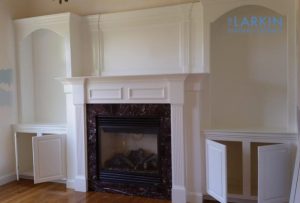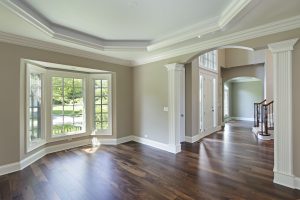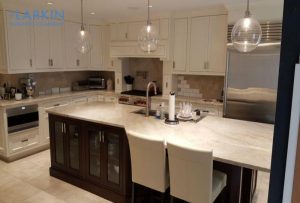Achieving the Perfect Spray Application
When I apply paint to a surface, I use one of two methods: applying paint with a paint brush or applying paint with a professional-grade sprayer. In the past and perhaps even today, many people think that applying paint with a sprayer as a short-cut or a lazy way to paint a surface. In reality, spray painting is a finicky, painstaking process that demands a deft touch, meticulousness and masterful execution. We use the Graco FinishPro Air-Assisted Airless. Professional sprayers deliver the control I need and produces the correct paint to air ratio which allows me to achieve the perfect finish.
One of the biggest challenges I face when spraying cabinetry or a large surface, is maintaining a pristine environment. On-site spraying requires an area completely free of dust particles and other contaminants. Minute dust particles are everywhere even in the cleanest home. Even walking around a room can cause dust to rise and move through the air to eventually settle on a newly-painted surface. The best way to have a dust-free environment is for me and my team to be the only people on-site. However, we often work in busy homes so it is usually impossible to have completely isolated spraying conditions.
Because any movement by us or our clients can cause the “natural” dust to settle on wet surfaces and ruin the finish of the paint, we thoroughly clean the area before we begin spraying. When I use this technique, usually I am working on a large surface area or I am working with many individual pieces such as cabinet doors. One newly painted cabinet door at a time is not an issue, but an entire wall, many lengths of wall trim, or a full room’s worth of cabinet doors is when the process gets especially tricky.  To keep dust from settling on wet surfaces, it is imperative that I thoroughly clean the area immediately before beginning our work. I must work steadily, carefully and as quickly as possible in order to limit the number of people who might pass by the area and also to limit the amount of time surfaces are vulnerable to potential dust exposure.
To keep dust from settling on wet surfaces, it is imperative that I thoroughly clean the area immediately before beginning our work. I must work steadily, carefully and as quickly as possible in order to limit the number of people who might pass by the area and also to limit the amount of time surfaces are vulnerable to potential dust exposure.
Another challenge is the more intensive prep work that spraying requires. My team and I carefully sand all surfaces regardless of whether we paint with a brush or a sprayer. However, when I paint with a hand brush, imperfections that you can barely see with the naked eye are not noticeable because they blend in with the character of the brushstrokes for a pleasing effect. Sprayed surfaces amplify barely perceptible blemishes, so sanding and smoothing a surface takes more time when we spray versus brush paint onto the surface. When expertly applied, sprayed surfaces look and feel like highly-polished glass. This incredible finish is my favorite thing about using the spray application. It is just beautiful. I love seeing that perfect, glassy luster on cabinets, trim, walls, built-ins and doors.  It accentuates the beauty of new woodwork. I prefer a sprayed finish for new, unpainted wood surfaces. When you paint new wood with a paint brush, the surface will always show the painter’s brushstrokes. If you think you might want to use a spray application in the future, spraying will not erase the brushstrokes.
It accentuates the beauty of new woodwork. I prefer a sprayed finish for new, unpainted wood surfaces. When you paint new wood with a paint brush, the surface will always show the painter’s brushstrokes. If you think you might want to use a spray application in the future, spraying will not erase the brushstrokes.
When our clients see that perfect sprayed finish, that result is never an accident or a fluke. There are years of craftsmanship underneath those glass-smooth coats of paint. They are seeing the evidence of fastidious prep work, including thorough sanding and meticulous dust removal. Becoming an expert sprayer requires talent, years of learning and practice. Even though I have painted with sprayers for over fifteen years, every job is different and exciting. Our clients love the results. That makes the process very rewarding. I always enjoy the meticulous process and I am always proud of the end result.
If you would like to know whether the spray technique is appropriate for your project, give us a call at 508-740-6212 or fill out the form on our website. We are here to transform your vision for your home into reality.
Emerson



